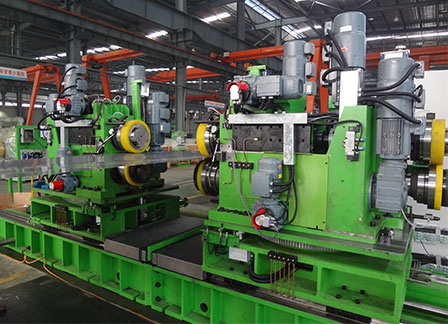Requirements for Mold and Equipment in Fine Blanking Process
Fine blanking requires the use of fine blanking machines
Fine blanking requires equipment that can provide punching force, edge pressing force, and counterforce. This is typically done on dedicated fine blanking machines. Ordinary punching machines cannot provide all three forces and their movements at the same time. They also have lower rigidity and precision in motion. Therefore, fine blanking should not be done on ordinary punching machines unless certain technical measures are taken, such as installing mechanical or hydraulic devices to provide edge pressing force and counter pressure, which allows for fine blanking on universal punching machines. Using hydraulic devices to provide edge pressing force and counterforce allows for pressure balance, pressure maintenance, or pressure reduction according to process requirements, resulting in simple control. Therefore, hydraulic force is commonly used to implement edge pressing force and counterforce in fine blanking on ordinary punching machines.
The gap between fine blanking dies cannot be too large
A small gap is a key characteristic of fine blanking dies. The size of the gap and its evenness along the cutting edge directly affect the quality of the shear surface of fine blanking parts. Fine blanking gap mainly depends on material thickness, as well as stamping profiles and material properties of the workpiece. If the gap is too large, the shear surface will be torn. This is because a large gap causes significant stretching of the material in the deformation zone, inducing tensile stress, which is the main reason for inducing microcracks and tearing. Therefore, the gap between the convex and concave molds in fine blanking cannot be too large.
The edge pressing force in fine blanking cannot be too small
Fine blanking often uses a V-shaped gear pressure plate for strong edge pressing. The role of the V-shaped gear pressure plate is to:
Prevent material outside the shearing zone from flowing into it with the convex mold during shearing.
Clamping the material to keep it vertical to the punching direction during fine blanking.
Provide strong pressure to establish a three-directional pressure stress state in the deformation zone, eliminate or prevent cracks caused by tensile stress, and prevent tearing of the cutting surface.
To ensure the shearing quality of stamping parts, reduce power consumption, and extend mold life, edge pressing force must be calculated and set correctly. If the edge pressing force is too small, the static hydraulic stress in the deformation zone of the material will be low, which is not conducive to inhibiting cracks, causing tearing on the shearing surface and affecting shearing quality. If the edge pressing force is too large, then it leads to excessive power consumption, complex mold structure, and reduced mold life. Therefore, the edge pressing force must also be adjusted during the actual technical process.
The counterforce in fine blanking cannot be too small
Counterforce is an essential factor affecting the quality of fine blanking parts. A larger counterforce can increase the compressive stress of the material in the deformation zone and inhibit tensile cracks, which helps to improve the quality of fine blanking parts. However, if the counterforce is too large, it will increase the load on the convex mold and reduce the life of the stamping mold. If the counterforce is too small, it will affect the dimensional accuracy, flatness, die collapse angle, and cutting surface quality of the stamped parts. A smaller counterforce causes the stamping part to have a larger collapse angle, making the surface uneven and arching in the middle. Therefore, like edge pressing force, the counterforce also needs to be adjusted to the lower limit value during the actual technical process, while ensuring the quality of the stamping parts.
The flanging value in fine blanking cannot be too small
As fine blanking requires the V-shaped gear pressure plate to clamp the material, the flanging value is larger in fine blanking than in ordinary punching. The design principles of the fine blanking layout are basically the same as those of ordinary stamping. The correct selection of the flange value in fine blanking has a significant impact on the quality of the stamping parts. Generally speaking, the larger the flange value, the more favorable it is to improve the section quality of the fine blanking. However, this is not economical. Therefore, when selecting the flange value in fine blanking, the minimum value that meets the requirement for the cutting surface quality should be chosen to ensure the quality of fine blanking products while maximizing the use value of the material.
Typical structures of fine blanking dies include active convex mold structure, fixed convex mold structure, and continuous fine blanking dies
Fine blanking process requires precise punching force, edge pressing force, and counterforce. Therefore, high-volume production of fine blanking parts generally uses fine blanking machines, but the equipment investment cost for fine blanking machines is high. Therefore, many fine blanking press manufacturers use hydraulic frames for fine blanking parts on hydraulic presses. Hydraulic presses have low cost and are suitable for producing fine blanking parts with many varieties and small to medium batches. However, the quality and production efficiency are relatively low, and they are suitable for manufacturers with low added value and relatively low precision and production efficiency for fine blanking products.
Topics You May Be Interested in:
Roll Coating Process
Backup Rolls
Precision Blanking
Conventional Stamping
Rubber Roller Coating Machine
Press Blanking
Popular BOYA Flat Metal Processing Machinery
Other Articles about BOYA Flat Metal Processing Machinery

 English
English 




